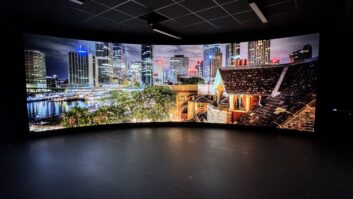
Previously we revealed that key players in XR are shifting their attention away from the consumer market and towards enterprise, before considering some of the challenges and barriers to mainstream AV adoption. In the final part, Ian McMurray looks at whether the wait for XR to deliver in AV is over.
Will this year be the year that XR technologies break out, go mainstream and turn their undoubted potential into widespread use cases that deliver worthwhile business benefits? Fabien Barati, CEO of French VR and AR company Emissive, is hopeful.
“In 2020, we will certainly see more complete and profitable business models based on those technologies for different use cases such as entertainment, brand experiences, education, training, visualisation and retail,” he believes.
“One of the biggest limitations to using XR technologies in the commercial space has been the hardware,” acknowledges Holovis creative director, Peter Cliff. “Products haven’t been robust enough to cope in the entertainment space, or high enough resolution for the detail needed in enterprise. I think we will see this change in 2020 as products like the HoloLens 2 and the HTC Vive Cosmos get released to the wider market with new features including better gesture control, wider fields of view and inside-out tracking making them much more suited to the needs of the market.”
“XR has promised to be the next frontier in personal computing for the last decade”
James Manning Smith, Futuresource
Manning Smith is somewhat more circumspect. “XR has promised to be the next frontier in personal computing for the last decade,” he notes, “and we’re still waiting for the industry to deliver on its potential.”
IDC research analyst Giulia Carosella is, however, positive about the medium term.
Focus shifting
“AR/VR commercial uptake will continue to expand as cost of entry declines and benefits from full deployment become more tangible,” she says. “Focus is shifting from talking about technology benefits to showing real and measurable business outcomes, including productivity and efficiency gains, knowledge transfer, employee’s safety, and more engaging customer experiences.”
It’s worth noting, of course, that neither Barati, Cliff, Manning Smith nor Carosella is speaking specifically about XR technologies in the AV space: they’re talking about the XR market in general. Peter Cliff provides a possible explanation.
“The use cases are completely different for large scale AV compared to VR, AR or MR,” he says, “although the two can work together to complement each other. Regardless of which platform you’re working with, XR technologies are not currently geared up for large scale communications – so traditional AV systems, and especially secondary screens, will continue to be the primary focus for a long time yet.”
“AR is really different from XR,” echoes Barati, “with different use cases and a different skillset. XR should be done mainly by people coming from the videogame industry. Those are the technologies that underpin XR.”
“I don’t think there is necessarily any problem for the AV industry in accessing markets or opportunities in XR,” counters Oliver Ellmers, interactive developer at Pixel Artworks. “I think there is more a need to take a step back and assess how these new technologies may be adapted to the AV industry, and how they can aid in traditional AV storytelling processes.”
Legend has it that the Walkman came about as a result of a senior Sony executive wanting to be able to listen to opera on a more convenient device than Sony’s then-current TC-D5 cassette player. The Walkman, Sony’s seeming solution looking for a problem, sold some 400 million units and was still in production 30 years after its introduction. It could be said that the Walkman was the progenitor of portable CD players, the iPod and huge numbers of alternative MP3 players. Today, anyone with a mobile phone also has, by definition, a portable music player. That another solution widely believed to be looking for a problem – XR – represents a similarly enormous opportunity to achieve comparable levels of success seems probable.
Enormous opportunity?
The question remains, however: is it an enormous opportunity for the audiovisual industry – or even any kind of opportunity? The answer is probably a qualified “yes”. XR is already well established in markets in which the AV industry has traditionally succeeded – notably retail, education, unified communications, entertainment, training, simulation and control rooms, for example. XR technologies can unquestionably extend the scope and utility of existing solutions. That’s all reinforced by the reappearance of the XR Summit at this year’s ISE: there are certainly knowledgeable people who see the fit.
Those traditional AV markets are, however, already served to a greater or lesser extent by specialist XR companies who have a head start in skills, knowledge and experience. For integrators unable or unwilling to undertake the necessary investment, partnerships with those companies look to be the most promising way forward.
www.emissive.fr
www.futuresource-consulting.com
www.holovis.com
www.idc.com
www.pixelartworks.com







